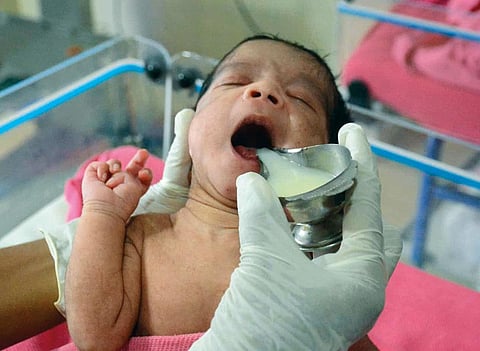

Early this year year, Poonam (name changed) from Amravati in Maharashtra lost her four-month-old son following a surgery to fix a hole in his heart. Amid the grief and loss she found a purpose that kept her going.
“My son was admitted to the neonatal intensive care unit (NICU) at the Kokilaben Dhirubhai Ambani Hospital in Mumbai. There were two other babies in the NICU. One mother was not able to express milk. So I offered to give her child my milk instead of formula,” Poonam said.
After losing her son, Poonam decided to continue donating her milk rather than take medication to stop lactation. “After returning to Amravati, I started going to the human milk bank at Dr Panjabrao Deshmukh Memorial Medical College and donated 100-120 ml daily for over a month,” she said.
Women like Poonam are the backbone of India’s human milk bank network.
Breast milk is the ideal food for infants, according to the World Health Organization (WHO). It contains nutrients and antibodies crucial for their early days.
WHO recommends that infants be exclusively breastfed for the first six months. If mother’s milk is not available, it says donated milk is the next best option.
Brazil is a key example for a successful network of human milk banks; the first facility there was set up in 1943. Today, it has the world’s largest human milk bank network. The country had 218 of the 301 human milk banks in the region in 2015, according to the Economic Commission for Latin America and the Caribbean.
Paediatricians stress the need for such a robust network in India. Data with the Union Ministry of Health and Family Welfare show that of the 27 million children born in the country in a year, 7.5 million have low-birth weight and 3.5 million are born preterm.
Some 30-50 per cent of infants in NICUs and 10-15 per cent of babies in special newborn care units needed donor human milk (as of 2017), stated the ministry.
A preterm baby will need 30 ml of milk per day while a healthy baby could consume up to 150 ml. In 2017, the ministry introduced guidelines for establishment of lactation management centres in the country and mandated setting up human milk banks in healthcare centres at district and subdistrict levels.
Arun Gupta, a paediatrician and founder of the Breastfeeding Promotion Network of India (BPNI), an association of organisations and individuals that promote breastfeeding, said these measures are merely lip service.
“In terms of the growth and scale of the banks, what India has been doing is nowhere close to what Brazil has achieved,” he said. Satish Tiwari, national convener of the Human Milk Banking Association of India, a network of healthcare providers who work on child nutrition and maternal health, explained:
Currently, milk banks just about meet the demand of their hospitals. However, not every child who needs this milk will be in hospital.
Hence several infants will miss out on needed benefits.
Till 2013, the number of human milk banks stagnated at 8-10 in a few states, he said. In 2017, this rose to 80 banks, as per the Union health ministry's guidelines; the national capital only got its first milk bank that year, at the Lady Hardinge Medical College. Now, the number has increased marginally to 100, said Tiwari.
“Ideally, all metro cities must have at least 50 milk banks each. Currently, Mumbai, Bengaluru and Chennai have five to six banks, Delhi has two to five and Kolkata has one or two,” he added.
This growth is slow, given that the first such facility was established in 1989, in Mumbai’s Sion Hospital. Armida Fernandes, former professor of neonatology with the hospital, recalled that there were high mortality rates in preterm babies in the 1970s and 1980s.
“Among the causes of death was the use of formula milk,” she said. Fernandes was inspired to suggest a human milk bank after hearing of a similar setup in Oxford, UK.
“We pushed for mothers to be allowed in the care unit for premature babies,” she says. Initially, a mother’s milk would be stored for her own child. “However, some mothers could not express milk so we would give a mother’s milk to another child. It was considered unscientific at the time, but I saw mortality decreasing,” she added.
Exploitation risk
Apart from supply issues, the lack of a regulated milk bank system also risks exploitation of women. A 2020 study by Sarah Steele, senior resea rch associate, University of Cambridge, says a profit-making human milk market is on the rise in India and some other countries.
The Union health ministry and the Food Safety and Standards Authority of India (FSSAI) do not allow commercial use of breast milk. Yet, Bengaluru-based NeoLacta Lifesciences Pvt Ltd reportedly sells 300 ml of frozen breast milk for Rs 4,500. It claims to be the first company in India and the rest of Asia to have a human milk processing facility.
In June 2020, BPNI filed a Right To Information (RTI) application, enquiring about the licence under which NeoLacta sells human milk. The RTI response says the licence was issued by FSSAI's state unit, but was cancelled.
In 2021, FSSAI conducted an inspection of NeoLacta and found that it had obtained a licence from the Union Ministry of Ayush in November that year to sell breast milk as a ‘Positive Health Promoter-Ayurveda Propietary Medicine’. Neither NeoLacta nor the Ayush ministry responded to Down To Earth's queries on the licence till the magazine went to print.
A December 2020 study by UK-based researchers, published in the Review of International Political Economy, claims NeoLacta acquires milk from women in villages of at least four states. These women “are largely uneducated, hard to convince, and receiving either financial support or food,” they wrote. Such commercialisation could lead to exploitation and trafficking of women and girls.
This was first published in Down To Earth’s print edition (dated 1-15 August, 2022)